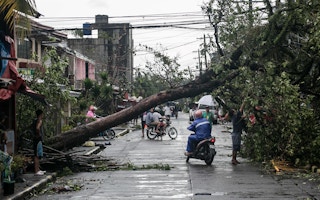Climate change is impacting agriculture, forests, mountains and oceans, and is making droughts, floods and storms more frequent and more severe. People are adapting to some of these impacts. Some impacts are beyond adaptation – they are causing loss and damage.
That is why developing countries have been lobbying the UN Framework Convention on Climate Change (UNFCCC) for years to include loss and damage in global climate negotiations. Most developed nations, led by the US, have been stoutly opposing this, fearful of a plethora of compensations claims in courts around the world, filed by affected people and accusing the rich country governments of causing the loss and damage.
Under pressure from NGOs and developing countries, the Warsaw International Mechanism for Loss and Damage (WIM) was in 2013 established to support countries already experiencing disasters induced or worsened by climate change.
The December 2-13 UN climate summit was scheduled to figure out how to finance WIM, to support developing countries recover from the loss and damage.
That is now unlikely, according to Harjeet Singh, global lead on climate change for the non-profit ActionAid and a member of the WIM executive committee, because “sensing growing pressure on the rich countries and polluting industries most responsible for the climate crisis to act, the US is now attempting to add further protections for itself and fossil fuel companies by inserting a liability waiver into the complex web of international climate legislation.”
No financing solutions
As a result, even six years after it was established, the WIM has failed to propose concrete financing solutions that would enable hard-hit communities to receive support in the form of finance, technology and capacity building.
Instead, Singh alleged, “The US is using the opportunity to make changes to the way the WIM is governed, to cover its own back and keep developing countries hit by climate disasters mired in debt and poverty.”
“We already know the US is deeply hostile to climate action and global cooperation. But after pulling out of the Paris Agreement, the Trump administration is now making a cynical and paranoid play to further distance itself from responsibility for the harmful impacts of climate change and to further protect itself and other polluters from liability for the crisis,” the New Delhi-based activist added.
“At the same time, it is insisting on remaining part of the decision-making body for loss and damage finance, so that it can continue to bully developing countries and block proposals for a fund to support survivors of climate disasters.”
The WIM must be governed by both the Conference of the Parties (COP) of the UNFCCC and the CMA, the body responsible for bringing in the Paris Agreement.
Liability waiver
“The US is using the review of the WIM to insert a liability waiver into global climate legislation on loss and damage, hoping to leverage more legal protection for its government and polluting corporations against liability and responsibility for the impacts of climate change,” Singh said.
This relates to a decision made in the last-moment negotiations for the Paris agreement during the 2015 UN climate summit, when a paragraph (number 51) was added to Article 8 of the agreement to provide a liability waiver. Singh said this waiver was put into a COP decision and not the Paris Agreement itself. The paragraph says Article 8 of the Agreement does not involve or provide a basis for any liability or compensation.
Singh said the US is now pushing for all parties to the convention (COP), including those who have not signed up the Paris Agreement (the US), to be on the WIM executive committee.
“In practice, this means that the countries least responsible for the crisis, but who are suffering the most, could stand even less chance of receiving financial support to recover from the devastating impacts of increasingly frequent and severe droughts, flooding and sea level rise,” Singh charged.
“The US is obstructing the creation of a new system designed to help communities where the climate crisis is already causing immense suffering,” he added. “It is preventing any progress on the architecture needed to provide vital finance to those on the frontline of climate change.”
This story was published with permission from The Third Pole.










